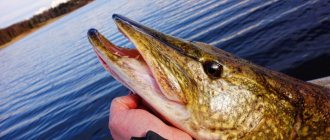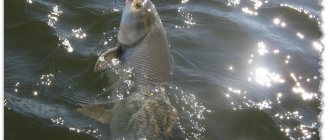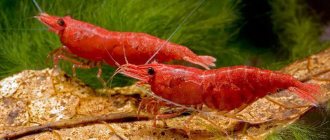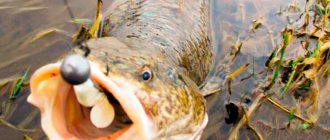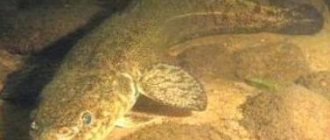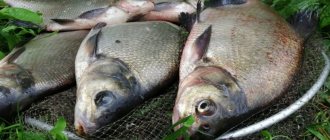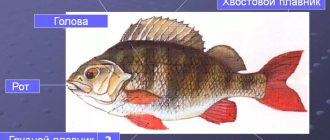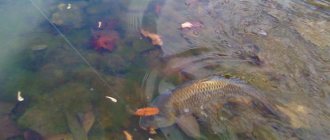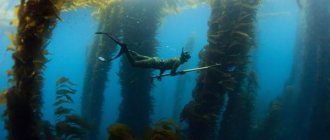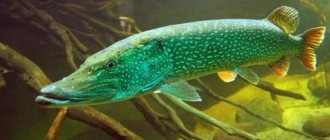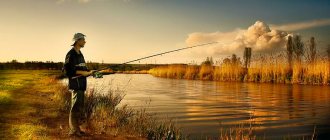Buy quality products at affordable prices in the best fishing online stores
. Give gifts to yourself and your loved ones!
we are in social networks
— subscribe to us on Facebook, Youtube, VKontakte and Instagram. Stay up to date with the latest site news.
An excellent bait for fishing is the caddis fly. It is also called shitik. This is a butterfly larva that lives near bodies of water. It has different colors and lives at the bottom of reservoirs. This is natural food for fish, so they confidently bite on caddis flies. In this article we will look in detail at how to find a caddis fly larva anywhere, how to put it on a hook, and how to catch fish with a caddis fly.
General information about caddisfly
The larva has dark and light colors and an elongated body from 2 to 4 cm. Without a house, the shitik looks like a maggot. During its life, it often molts and constantly builds itself a shelter in the form of a tubular house, which protects it from attacks by inhabitants of the underwater world. After building the house, he wears it on his body. Only his head and legs are visible. During times of danger, the insect hides in its home.
Some species of caddisflies live on the surface of the water. This is not difficult for them, since the house is made of grass and wood chips, which are lighter than water.
The main food of caddisflies is algae and grass. Therefore, it is best to look for them among the underwater grass. In nature, there is a type of caddisfly that eats mosquito larvae, small ants and even small crustaceans. These are predators. But such caddis flies are usually not used in fishing.
Caddis flies
Caddis flies
With the massive appearance of caddisflies (Trichoptera), fly fishing can be very effective if the angler has at least a minimum of knowledge about relationships in the underwater world and knows how to use this knowledge. It is not enough to simply replace some artificial flies with others that imitate caddis flies; you also need to copy the behavior of an adult caddis fly on the water.
Below we will talk about the types and forms of caddisflies. This information is needed in order to avoid errors and inaccuracies that can ruin all the pleasure of fishing when making artificial flies depicting caddis flies and using them on a pond.
Adult caddis flies
The order of caddisflies (Trichoptera) includes small, medium and large insects with two pairs of well-developed wings, covered with fine hairs and having a few cross-veins. During rest, the insect folds its wings in the form of a gable roof covering the entire body. The antennae are very thin and long, often longer than the wing. Caddis flies are similar in structure to moths, and individual small individuals of both are easy to confuse. (Remember the misconception of Kiev fishermen, described in the mentioned article by I. Margal, who call the caddisfly a moth.) However, by several characteristic features caddisflies can be distinguished from other insects: hairs covering the wings (they are clearly visible under a magnifying glass with fourfold magnification), the absence of a coiled proboscis , a small number of veins on the wings, the position of the wings during rest, etc.
Caddisflies are fully metamorphosed insects, in the larval and pupal stages they mainly live in water. Of the more than three hundred species characteristic of the fauna of the European part of the country, only Enoicyla pusilla does not have an aquatic larva - it lives in damp moss at the base of trees.
Adult caddisflies are rather inconspicuous, brownish insects that usually fly at dusk.
Caddisfly larvae are much better known than adult insects and make up a significant part of the diet of fish and many birds. Anglers have long known about them, using them as bait.
As already noted, in adult insects the wings are covered with hairs and colored in grayish, bronze or dark tones, with a more or less pronounced pattern. The fore wings are narrower, more abundantly covered with hairs and not as transparent as the hind wings. The abdomen is usually shorter than the wings, relatively thick, of a dull yellowish color of various shades. The segmented antennae are very long, thread-like, extended forward. The underdeveloped oral apparatus is intended only for the absorption of liquid (water, nectar), since caddisflies do not feed as adults.
In the evening, caddis flies fly out of their hiding places and gather in dense clusters above the water. Mating occurs on coastal vegetation, and after some time the females lay eggs - some on bushes growing near the water, others on or under the water surface. The eggs develop within three weeks, after which they hatch into tiny, soft-bodied larvae.
Larvae and pupae
Individual parts of the body of a caddisfly larva are protected in different ways from environmental influences. Thus, the head is encased in a hard chitinous shell, in the chest area the chitinous cover is much thinner, and the tender abdomen is the least protected and is very vulnerable. Therefore, the larva hides in a characteristic case, known among fishermen as a “house”.
Having just emerged from the egg, the larva immediately begins to build the cover. At first, the gelatinous shell of the egg laying serves as the building material, but after a few hours the larva begins to complete the house with various small particles that it finds in the water. The gland located near the mouth produces an adhesive thread, which the larva winds around itself and to which it attaches “building material” - grains of sand, twigs, bark, fragments of mollusk shells, etc. The larvae of different types of caddisflies build different houses, so you can determine type of caddisfly due to the specific design and material of the cover.
As the larva grows, it completes the house at the front, expanding it, and often destroys the back part.
The cover is always open on both sides, although the back opening can be very narrow. With body movements, the larva moves the water in the case from front to back, thus providing a constant flow of oxygen, which it extracts from the water through feathery gills located on the sides.
Two powerful hooks at the end of the abdomen hold tightly to the threads lining the inner surface of the cap. With it, the larva forms a single whole, never separates, constantly carrying its shell on itself, like a snail. Larvae living in the turbulent waters of mountain rivers often add large grains of sand to their caps, which apparently protects them from being carried away by fast currents.
The larva of the caddisfly Anabolia nervosa , apparently protecting itself from hunters to feast on it, attaches one or several sticks to its case - in this form it cannot be swallowed by either fish or birds. Therefore, anabolia can lead a completely open lifestyle in trout rivers, while other larvae have to hide.
The well-protected head of the caddisfly larva, with developed jaws of a gnawing type, and movable legs can protrude from the cover and perform various movements. Together with the house, the larvae move from place to place in search of food. These are mostly omnivorous creatures, some of them are clearly prone to predation.
Not all larvae build caps: some weave a network among underwater vegetation that provides protection and, in addition, retains food. It is clear that the larvae of these species live in flowing waters, where food is brought to them by the current. Representatives of the genus Rhyacophila do not build houses or weave nets, but lead a free lifestyle, hiding in the bottom gravel. They are distinguished by a denser body cover.
Having reached a certain age, the larva attaches its case to some submerged object, seals it on both sides, leaving only small holes that provide an influx of fresh water, and while imprisoned undergoes transformation into a pupa. The larvae, which do not have cases, build a special chamber of sand in which they weave a cocoon.
The pupa retains gills on the sides of the body, has three pairs of well-developed legs, antennae and wings, as well as a pair of large jaws. With them she gnaws her way out of the cover.
Having left the house that it no longer needs, the pupa can wander around the bottom for several days, and then it either crawls to the surface or floats up, actively working with a pair of heavily pubescent legs. And she floats on her back. Having reached the surface, the pupa freezes in anticipation of the last molt in its life. The cover on the head cracks, then the resulting hole grows, reaching the back of the back, and an adult insect emerges from the split shell. Having dried, it begins to frantically flee across the surface of the water.
The emergence of adult caddisflies of the same species in a given reservoir often occurs almost simultaneously.
This completes the life cycle of caddis flies; adult insects are ready to reproduce. The usual lifespan of one generation of caddisflies is one year, with most of the time spent in the larval stage. Rare species overwinter in the pupal stage; most pupate in the spring, appearing in large numbers above the water in early summer.
V. Chesnokov
How to get caddis flies for fishing
Finding caddisflies is not that difficult. Their houses are visible in clear water. It is enough to pull out a bunch of algae and carefully examine it. Surely you will find Shitikov in considerable quantities.
To remove the larva from the house, you need to lightly press on its walls and carefully pull the insect out of the shelter. We take care not to damage it. Shitika can be found in shallow water in windows among vegetation. From a small patch you can collect several dozen of this valuable bait.
You can get the larvae using a small net with a fine mesh. At the bottom, covered with snags and branches, there will always be a few good branches. On such branches you can often find several caddisfly larvae.
The easiest way to get larvae is to take a large stick and lower it to the bottom with algae. Next, you need to wrap the grass around a stick and pull it all ashore. On the shore, you calmly and methodically sort through the grass and look for larvae in it.
There is another interesting way to catch caddisflies. Collect branches that are lying on the shore of a pond. A broom is made from them, which is sprinkled with flour. This broom is placed at the bottom of the reservoir for about a day or two. After this, the broom is removed and the larvae are selected. One broom produces 3-4 dozen larvae.
It has long been established that the best baits are large dark green larvae. However, with all this, the caddisfly can quickly die if the proper conditions are not created for it.
They can also catch caddis flies in winter. It is mined at a depth of 2-3 meters. In cold weather, many insects live at this depth. It is obtained using special traps. In winter, caddisflies are valued almost as much as bloodworms.
Shitik in the house: caddis larvae as catchable bait
Dear experts, is it true that the caddis larva is a universal bait that all peaceful fish bite on? I recently heard such a theory from an authoritative fisherman, but I still doubt it. Also tell me what a caddisfly looks like and where it can be found.
Caddis flies (Trichoptera) are among the most widespread insects in the world with complete metamorphosis in the aquatic environment. The order includes more than 15 thousand species, the study of which is carried out by a separate branch of entomology - trichopterology. Caddisfly larvae (scientific - laurels; popular - shitiki) are found in rivers, streams, ponds, reservoirs, lakes on all continents (with the exception of Antarctica) and are the most important component of food chains in freshwater ichthyosystems.
Hundreds of caddisfly taxa have fossil status, indicating their ancient history. That is why a huge number of species of carp, perch, loach, salmon, sturgeon and other fish are programmed at the genetic level that this familiar, nutritious and safe food should be eaten first. Using shitikov for fishing as a universal bait, you can successfully catch crucian carp, carp, roach, perch, sterlet, whitefish, grayling, etc.
The appearance and lifestyle of the caddisfly larvae are so unique that it cannot be confused with other shallow water inhabitants. The light gray soft body looks like a caterpillar and usually consists of 9 sections. The first three have a pair of legs. The round dark head is equipped with impressive jaws for chewing plants. On the tail there are hooks for attaching to a solid substrate in the current. The main external feature of the laurel is a house-cover made of reeds, grains of sand or leaves. If “sticks with legs” move along drowned snags, shallow water or the bottom of a stream, this is definitely shit, which will become the optimal bait for all fish in the surrounding reservoirs.
To learn more:
Vobla - what kind of fish, description and way of life
Harvesting caddisfly larvae usually involves a simple visual search and hand collection into a bucket of cool water. Shitiki for fishing can be lured to a certain place if you press a small bunch of reeds, small branches, or dry grass to the bottom with a stone in advance. Such a natural shelter is filled with many larvae in just a day. All that remains is to carefully remove the bunch and shake out the shitiks into a container of water. When fishing, you need to regularly change the water in the bucket with bait to prevent the larva from dying from overheating. But you can’t just drain the liquid over the edge of the container while holding the cover houses with your fingers. A weakened shitik often falls out of its hiding place and sinks to the bottom of the bucket. Several careless water changes can leave a fisherman without a catchable bait.
How to Store Caddisflies for Fishing
Anglers store caddis flies in a wet cloth, folded into a plastic bait box. You can store them while still in wet foam. They are used when packaging household appliances. In such conditions, caddis flies can be stored for several days. The main thing is that they are in their own house. If you deprive him of his natural home, he will die very quickly.
If you need to preserve the caddisfly for a longer time, it is placed in cellophane. The larvae are arranged in an even row so that they do not touch each other. You can put them in small bags like this:
We first put the larvae in one bag, and then put this bag in another, slightly larger one. We place these bags in the refrigerator and store them there at a temperature of +3 degrees. You can also store them in the freezer. But these will be non-living larvae. We take them out before fishing. During the trip they will thaw and become suitable for fishing.
How to plant a caddisfly
Before planting, the larva is removed from the house. It is necessary to apply light pressure and break this shell. Caddis flies are mounted in several ways. We deal with it in much the same way as with maggots. Some people pierce the floor with a stinger and insert a hook. The nozzle will hang down. You can put a stocking on it like a worm. Another way is to pierce the body crosswise in the middle and leave the sting open.
They put another ring on it, like a bloodworm, and thread a few more larvae through. The figure shows options for baiting a caddisfly larva on a hook.
If the bite is active, then plant 3.5 caddis flies. When biting is sluggish, one is baited with a stocking so that the sting is hidden inside the larva.
About caddisfly larvae
If there are caddisfly larvae in a reservoir, this means that the water is clean. They settle in the bottom sediments of freshwater rivers, lakes and streams. The larval stage is the longest in the life of an insect , this period lasts up to 2 years before the larva turns into an adult butterfly.
The caddisfly, as well as its larvae at all stages of their development, are of great interest to fishermen, since any fish always willingly bites on them.
They live near water or in water, you can always find them there and hook them. Caddisfly larvae always build their own houses from materials they find in the water, often resulting in simply unique structures. You can see this by looking at the beautiful photos.
How to catch caddis flies
They catch caddis flies with all peaceful gear. If you fish with a fishing rod using a line, use a fishing line 0.16-0.2 mm long and a hook No. 12-14 on a leash 6-8 cm long. A sliding sinker is used. The float is selected for fishing in the wire. It usually has a spherical or drop-shaped shape.
In general, it’s nice to fish for caddis using a fly rod and light equipment. All even the most gentle bites will be recorded and hooks will be timely. The delicate body of the caddisfly is often pulled off the hook on rough rigs. Therefore, it is better to hang several larvae to see the bites.
When fishing in the current, you can expect decisive bites from roach and bream. In this case, the float suddenly sinks or floats to the side. In such cases, you need to wait a little and let the fish swallow the bait well. It should be pulled out in such a way that it does not go into the grass or reeds. In this case, a descent is almost inevitable.
The caddisfly holds well on the hook. Almost like a maggot. That’s why feeders and bottom hunters catch it. As a rule, when fishing with a long cast, 3 or more larvae are attached to the hook. The same principle is used as when planting maggots, when an unpaired number of larvae are hung on a hook.
Fishing with caddis larva
It should be remembered that fish react extremely actively to caddis flies only in spring, namely from the beginning of May until the first weeks of June. They fish for caddisfly in winter, but it is extremely difficult to catch it.
The most preferred tackle for catching caddis flies is a float rod. Before baiting the hook (with any gear), you need to remove the larva from its house. By the way, the fish especially prefer dark green caddis flies.
Having chosen a feeder or a traditional donka, you can safely cast the bait in creeks or lulls formed not far from the main current. Fishing on the rifts and backwaters will also be successful.
If the bank is steep and the current is strong, you can use fishing line. Bait actively moving in the water layer is unlikely to leave a good chub or bream indifferent.
This is interesting: Dragonfly
